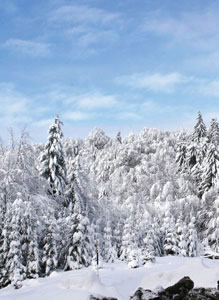Stress medicine
Need a quick break away from the city? Want to check into a top class resort at the top of a mountain? Explore the evergreen delight of Poiana Brasov and its surroundings
 Not just a centre for skiing, Poiana
Brasov is an all-season mountain resort,
situated in Brasov county, near the city’s
namesake and surrounded by coniferous
forests.
Not just a centre for skiing, Poiana
Brasov is an all-season mountain resort,
situated in Brasov county, near the city’s
namesake and surrounded by coniferous
forests.
The break in the woodland lies at the
foot of the Postavarul Massif, in the
Southern Carpathians, at an altitude of
1,030 m and 12 km south west of Brasov.
The clean air, the relatively low atmospheric
pressure and a marked ionisation
here are the natural remedies recommended
in the treatment of various
health problems including stress and
exhaustion.
Sporting chance
Poiana Brasov is Romania’s most renowned winter sports resort as well as an important international tourist centre. The small town boasts 12 ski runs of various degrees of difficulty. There is an Olympic run, three downhill and giant slalom runs, one special slalom run and two ski jumping hills. Other activities include sports grounds, tennis, minigolf, handball and basketball. Accommodation is provided mainly in luxury and first-class hotels and in a few villas and chalets.
Hike it up
Trips are recommended to the summits of Postavarul (1,602 m) and Cristianul Mare (1,704 m) as well as to the peasant citadel of Rasnov (built between the 14th and 17th centuries ), 14 km away, which boasts fantastic views.
Eye on culture
Bored of skiing or getting your boots muddy in the woods? Then day trip visits are easy to make to the redeveloped historical and art monuments in Brasov. Its centre, built between the 14th and 18th centuries, has been perfectly preserved in a labyrinth of pedestrianised streets in which a traveller can lose oneself. Antique monuments include the towers and bastions of the old 15th century fortifications and St. Bartholomew’s Church from the Gothic period. The Black Church, which was built between 1385-1476, now harbours a vast collection of oriental rugs. The Brasov Council House, built between 14th-18th centuries is today a wonderful museum.
So spa so good
Heal your body with the cures in Vatra Dornei and then do the same for your soul with a pilgrimage to the painted monasteries
Vatra Dornei in Suceava county is
situated at the confluence of the rivers
Dorna and Bistrita, in one of the most
beautiful depressions of the eastern
Carpathians, the Tara Dornelor, at an
altitude of 802 to 808 metres, 110 km
south west of the city of Suceava.
Spas are very popular in this part of
the countryside.
The springs of carbonated, ferruginous,
slightly bicarbonated, sodic,
calcic, magnesium and hypotonic
mineral waters are favoured mainly
for the treatment of cardiovascular
diseases.
The two treatment compounds in
this resort, Hotel Caliman and the
Dorna Balneal Complex, have a daily
capacity of over 4,500 therapeutic
procedures: warm mineral-water
baths in tubs, applications of warm
mud and paraffin, electrotherapy, hydrotherapy,
massage, medical gymnastics,
sauna and kynetotherapy.
There are also special fountains for
internal cures with mineral water.
Accommodation is possible in hotels,
villas and private homes.
GET BACK TO NATURE
Vatra Dornei is also an ideal place for relaxation and leisure, with many opportunities for mountaineering and winter sports. A chair lift extending over a distance of 3,200 m connects the town to Dealul Negru (at a height of 1,300 m). Vatra Dornei has a fantastic natural park, which is famed for its numerous families of squirrels and for the brass band concerts given here in the summer. In addition to this there is the chalet on Runc Hill, the Hunting and Natural Science museums, as well as the Bucovina Ethnographic museum.
GET AQUAINTED WITH THE PAINTED
The travel agency in the resort organizes many different trips by coach, the most interesting of which are visits to the famed monasteries of northern Moldova. These include Voronet (1488), Humor (1530), Moldovita (1532) and Sucevita (1581-1601). Frescoes on the interior and exterior of these churches contain a rich and passionate depiction of Biblical and historical fables. They include the Last Judgment at Voronet, the Siege of Constantinople at Moldovita and the depiction of the devil as a woman in Humor.
